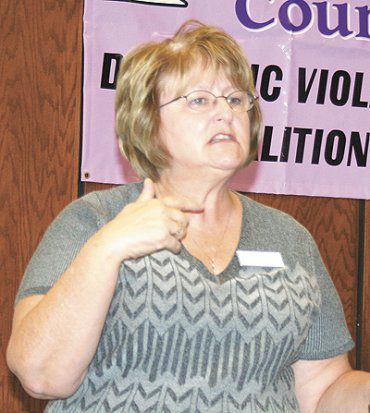As a stone is thrown into the water and creates ripples, so does domestic violence create ripples in the lives of those affected by the offender. Each person in the life of a victim is affected is some way, and children are affected in brain development.
Jacci Graham of the Children’s Service Society, Grandfamilies organization presented a program during the 10th annual Emery County Domestic Violence Coalition luncheon. Grandfamilies provides support for kinship caregivers. Those caregivers are defined as someone who is caring for and raising any relatives child. In Salt Lake, Utah, and Davis counties alone, there are more than 12,000 children in kinship caregiver situations.
Kinship caregivers are raising a child of a relative mostly due to drug abuse situations. These types of relationships allow a child to recover and heal while still retaining some connection to their own family.
Graham said, “Most people have no idea how drug abuse by a parent can affect a child. Most of the abuse in these situations comes from neglect. Neglect is so damaging on the emotional side. Physical abuse heals relatively quickly compared to emotional abuse. In a neglect situation, the child begins to feel they are not worth being taken care of.”
Graham suggested a moment of silence for the victims of domestic violence for those caught in the ripple effect. The victim is abused, then abuse passes to the children, then to others in the immediate vicinity, then extended family members, teachers, friends, law enforcement officers, and then on to the taxpayers. “We need more education for victims, with highlights on the ripple effects to children,” said Graham.
There is a need to break the cycle and understand why a person chooses to stay in a domestic violence relationship, or leaves one only to end up right in the center of another. A person who leaves a domestic violence situation immediately begins to think about the basic necessities of life including housing, food and shelter. Meeting their physiological needs is the most basic requirement. They begin to think that if they do not go back, they will no longer be able to feed the children or supply a place to live. That is the reason most people go back into the abusive relationship.
Graham said counselors should be aware of this and make arrangements to meet the immediate physiological needs of the children and the parent who has left the situation. When that immediate need is met, the other needs, such as treating the mental health issues can be taken care of next.
“We cannot fix what has happened, we must work to teach the victim to build a better tomorrow,” Graham said. “We must help them center in today and not dwell on the yesterday.”
The brain is divided into three parts, the stem, the mid section, and the cerebral cortex. The brain stem controls all the bodily functions so a person does not need to think constantly about taking a breath and other automatic things. The mid section of the brain regulates emotions, the pleasure center, and the fight of flight mechanism. The cerebral cortex deals with problem solving, planning, conscience, language, creativity and the God spot. If a brain is caught in the mid section, reasoning is out of the question.
To deal with an abuse victim, the brain must be calmed from the mid section before you can reason with them. Graham said the best way to do that is to have the person take three deep, calming breaths. This shuts down the fight or flight mechanism and brings some reasoning back.
In children involved in abusive situations, the physiology of the brain changes and certain parts shut down. Healthy brains have well developed cerebral cortexes and an abused child with an underdeveloped cortex have no coping mechanisms. A child’s exposure to domestic violence decreases their productivity and coping skills.
Graham gave several tips for first responders to a domestic violence situation. Mirror image the victims behavior. This helps the victim to connect with the responder. Have the victim take several deep, cleansing breaths before questioning the victim. Also, ground the client in the “here and now.” Create an atmosphere for forward thinking.
First responders must also set strict boundaries for themselves including proximity limits. They must obtain the proper training and get help for their own issues before trying to help someone else. A first responder must get help if: they want to continually talk about cases; they no longer feel empathy to the victims; and is they are experiencing sleep, anger, or sex issues.
Domestic violence awareness luncheon

"Jacci Graham speaks to the coalition."
